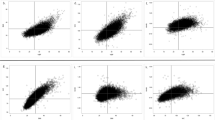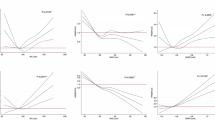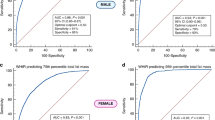Abstract
Background
The Chinese famine occurred between 1959 and 1961. Findings on early exposure to famine on obesity have been inconsistent. Therefore, this study aimed to assess the effect of early exposure to famine on obesity and the mediating role of testosterone.
Methods
The design enrolled 2667 participants from the Henan Rural Cohort Study. The associations between early famine exposure and indicators of obesity and obesity were explored using generalized linear models and logistic regression models, respectively. Stratified analyses by sex were performed to account for potential sex-specific effects. Mediation analyses were applied to address the contribution of testosterone in mediating the impact of early-life famines on obesity and its indicators.
Results
The median age of the study participants was 54 (range: 48–64) years old. Fetal famine exposure was positively associated with central obesity (waist circumference (WC) and waist-to-hip ratio (WHR)) in both sexes. Nevertheless, childhood famine exposure (3–9 years old after 3-year famine) was negatively associated with general obesity (body mass index (BMI)), and central obesity (WC) in males. In contrast, childhood famine exposure in females was positively associated with central obesity (WHR and waist-to-height ratio (WHtR)). Mediation analyses suggested that testosterone partially mediated the association of childhood famine exposure with central obesity (WC), BMI, WC, and WHtR in males, with mediation effect proportions ranging from 3.27% to 11.85%. In females, testosterone mediates the role of childhood famine in increasing the risk of central obesity (WHR), WHR, and WHtR, with mediating effect proportions of 5.50%, 3.60%, and 7.17%, respectively.
Conclusion
Fetal famine exposure increases the risk of central obesity. Childhood famine exposure showed sex-specific effects on central obesity, with a negative association in males and a positive association in females. Additionally, testosterone has been found for the first time to partially mediate the positive association of childhood famine on obesity.
This is a preview of subscription content, access via your institution
Access options
Subscribe to this journal
Receive 12 print issues and online access
$259.00 per year
only $21.58 per issue
Buy this article
- Purchase on SpringerLink
- Instant access to full article PDF
Prices may be subject to local taxes which are calculated during checkout



Similar content being viewed by others
Data availability
The datasets generated during and analyzed during the current study are available from the corresponding author on reasonable request, pending application.
References
Kolotkin RL, Andersen JR. A systematic review of reviews: exploring the relationship between obesity, weight loss and health-related quality of life. Clin Obes. 2017;7:273–89.
NCD Risk Factor Collaboration (NCD-RisC). Worldwide trends in body-mass index, underweight, overweight, and obesity from 1975 to 2016: a pooled analysis of 2416 population-based measurement studies in 128·9 million children, adolescents, and adults. Lancet. 2017;390:2627–42.
Boutari C, Mantzoros CS. A 2022 update on the epidemiology of obesity and a call to action: as its twin COVID-19 pandemic appears to be receding, the obesity and dysmetabolism pandemic continues to rage on. Metabolism. 2022;133:155217.
Piché ME, Tchernof A, Després JP. Obesity phenotypes, diabetes, and cardiovascular diseases. Circ Res. 2020;126:1477–500.
Pan XF, Wang L, Pan A. Epidemiology and determinants of obesity in China. Lancet Diab Endocrinol. 2021;9:373–92.
Wang Y, Zhao L, Gao L, Pan A, Xue H. Health policy and public health implications of obesity in China. Lancet Diab Endocrinol. 2021;9:446–61.
Chauhdary Z, Rehman K, Akash MSH. The composite alliance of FTO locus with obesity-related genetic variants. Clin Exp Pharm Physiol. 2021;48:954–65.
Mambrini SP, Menichetti F, Ravella S, Pellizzari M, De Amicis R, Foppiani A, et al. Ultra-processed food consumption and incidence of obesity and cardiometabolic risk factors in adults: a systematic review of prospective studies. Nutrients. 2023;15:2583.
Endalifer ML, Diress G. Epidemiology, predisposing factors, biomarkers, and prevention mechanism of obesity: a systematic review. J Obes. 2020;2020:6134362.
Li C, Lumey LH. Exposure to the Chinese famine of 1959–61 in early life and long-term health conditions: a systematic review and meta-analysis. Int J Epidemiol. 2017;46:1157–70.
Stephenson J, Heslehurst N, Hall J, Schoenaker D, Hutchinson J, Cade JE, et al. Before the beginning: nutrition and lifestyle in the preconception period and its importance for future health. Lancet. 2018;391:1830–41.
Zhang Y, Pu J, Ding Y, Wu L, Yin Y, Sun M, et al. Sex differences at early old stage in glycolipid metabolism and fatty liver in offspring prenatally exposed to Chinese Great Famine. Front Nutr. 2022;9:913966.
Hoffman DJ, Powell TL, Barrett ES, Hardy DB. Developmental origins of metabolic diseases. Physiol Rev. 2021;101:739–95.
Luo D, Kuo WC. Great leap forward famine exposure and urban-rural migration convolute the modern prevalence of diabetes in China. J Health Popul Nutr. 2024;43:109.
Smil V. China’s great famine: 40 years later. BMJ. 1999;319:1619–21.
Liu L, Pang ZC, Sun JP, Xue B, Wang SJ, Ning F, et al. Exposure to famine in early life and the risk of obesity in adulthood in Qingdao: evidence from the 1959-1961 Chinese famine. Nutr Metab Cardiovasc Dis. 2017;27:154–60.
Jiang H, Yu Y, Li L, Xu W. Exposure to the Great Famine in early life and the risk of obesity in adulthood: a report based on the China Health and Nutrition Survey. Nutrients. 2021;13:1285.
Liu D, Yang J, Wang S. Early-life exposure to famine and the risk of general and abdominal obesity in adulthood: a 22-year cohort study. Public Health. 2022;202:113–20.
Luo Z, Mu R, Zhang X. Famine and overweight in China. Rev Agric Econ. 2006;28:296–304.
Kelly DM, Jones TH. Testosterone: a metabolic hormone in health and disease. J Endocrinol. 2013;217:R25–45.
Fan C, Wei D, Wang L, Liu P, Fan K, Nie L, et al. The association of serum testosterone with dyslipidemia is mediated by obesity: the Henan Rural Cohort Study. J Endocrinol Invest. 2023;46:679–86.
Wei D, Hou J, Liu X, Zhang L, Wang L, Liu P, et al. Interaction between testosterone and obesity on hypertension: a population-based cross-sectional study. Atherosclerosis. 2021;330:14–21.
Lin CF, Lin CM, Lee KY, Wu SY, Feng PH, Chen KY, et al. Escape from IFN-γ-dependent immunosurveillance in tumorigenesis. J Biomed Sci. 2017;24:10.
Liu X, Mao Z, Li Y, Wu W, Zhang X, Huo W, et al. Cohort profile: the Henan rural cohort: a prospective study of chronic non-communicable diseases. Int J Epidemiol. 2019;48:1756.
Huo W, Hou J, Nie L, Mao Z, Liu X, Chen G, et al. Combined effects of air pollution in adulthood and famine exposure in early life on type 2 diabetes. Environ Sci Pollut Res Int. 2022;29:37700–11.
Meng R, Lv J, Yu C, Guo Y, Bian Z, Yang L, et al. Prenatal famine exposure, adulthood obesity patterns and risk of type 2 diabetes. Int J Epidemiol. 2018;47:399–408.
Huan C, Wang M, Song Y, Jia Z, Wei D, Wang L, et al. Inflammatory markers and androstenedione modify the effect of serum testosterone on obesity among men: findings from a Chinese population. Andrology. 2023;12:850–61.
GBD 2021 Diseases and Injuries Collaborators. Global incidence, prevalence, years lived with disability (YLDs), disability-adjusted life-years (DALYs), and healthy life expectancy (HALE) for 371 diseases and injuries in 204 countries and territories and 811 subnational locations, 1990-2021: a systematic analysis for the Global Burden of Disease Study 2021. Lancet. 2024;403:2133–61.
Song C, Wang M, Chen Z, Yao Y, Feng G, Ma Y, et al. Fetal exposure to Chinese Famine increases obesity risk in adulthood. Int J Environ Res Public Health. 2020;17:3649.
Liu D, Yu DM, Zhao LY, Fang HY, Zhang J, Wang JZ, et al. Exposure to famine during early life and abdominal obesity in adulthood: findings from the Great Chinese Famine during 1959–1961. Nutrients. 2019;11:903.
Ravelli AC, Van Der Meulen JH, Osmond C, Barker DJ, Bleker OP. Obesity at the age of 50 y in men and women exposed to famine prenatally. Am J Clin Nutr. 1999;70:811–6.
Srinivasan SR, Wang R, Chen W, Wei CY, Xu J, Berenson GS. Utility of waist-to-height ratio in detecting central obesity and related adverse cardiovascular risk profile among normal weight younger adults (from the Bogalusa Heart Study). Am J Cardiol. 2009;104:721–4.
Huang C, Li Z, Wang M, Martorell R. Early life exposure to the 1959-1961 Chinese famine has long-term health consequences. J Nutr. 2010;140:1874–8.
Ravelli GP, Stein ZA, Susser MW. Obesity in young men after famine exposure in utero and early infancy. N Engl J Med. 1976;295:349–53.
Wang Y, Wang X, Kong Y, Zhang JH, Zeng Q. The Great Chinese Famine leads to shorter and overweight females in Chongqing Chinese population after 50 years. Obesity. 2010;18:588–92.
Yao F, Zhao L, Yang Y, Piao W, Fang H, Ju L, et al. Association between early life famine exposure and metabolic syndrome in adulthood. Nutrients. 2022;14:2881.
Mu R, Zhang X. Why does the Great Chinese Famine affect the male and female survivors differently? Mortality selection versus son preference. Econ Hum Biol. 2011;9:92–105.
Barker DJ, Lampl M, Roseboom T, Winder N. Resource allocation in utero and health in later life. Placenta. 2012;33:e30–4.
Song S. Does famine influence sex ratio at birth? Evidence from the 1959-1961 Great Leap Forward Famine in China. Proc Biol Sci. 2012;279:2883–90.
Wang N, Huang Y, Wen J, Su Q, Huang Y, Cai L, et al. Early life exposure to famine and reproductive aging among Chinese women. Menopause. 2019;26:463–8.
Elias SG, Van Noord PA, Peeters PH, Den Tonkelaar I, Grobbee DE. Caloric restriction reduces age at menopause: the effect of the 1944-1945 Dutch famine. Menopause. 2003;10:399–405.
Luo ZC, Xiao L, Nuyt AM. Mechanisms of developmental programming of the metabolic syndrome and related disorders. World J Diab. 2010;1:89–98.
Chen YT, Hu Y, Yang QY, Son JS, Liu XD, De Avila JM, et al. Excessive glucocorticoids during pregnancy impair fetal brown fat development and predispose offspring to metabolic dysfunctions. Diabetes. 2020;69:1662–74.
Tobi EW, Slieker RC, Luijk R, Dekkers KF, Stein AD, Xu KM, et al. DNA methylation as a mediator of the association between prenatal adversity and risk factors for metabolic disease in adulthood. Sci Adv. 2018;4:eaao4364.
Wang Z, Song J, Li C, Li Y, Shen L, Dong B, et al. DNA methylation of the INSR gene as a mediator of the association between prenatal exposure to famine and adulthood waist circumference. Sci Rep. 2020;10:12212.
Grosman H, Rosales M, Fabre B, Nolazco C, Mazza O, Berg G, et al. Association between testosterone levels and the metabolic syndrome in adult men. Aging Male. 2014;17:161–5.
Zhou J, Zhang L, Xuan P, Fan Y, Yang L, Hu C, et al. The relationship between famine exposure during early life and body mass index in adulthood: a systematic review and meta-analysis. PLoS ONE. 2018;13:e0192212.
Chen K, Shen Z, Gu W, Lyu Z, Qi X, Mu Y, et al. Prevalence of obesity and associated complications in China: a cross-sectional, real-world study in 15.8 million adults. Diab Obes Metab. 2023;25:3390–9.
Liu C, Li C. The need for appropriate ‘age-balanced’ controls and transparent reporting in Chinese famine studies: a re-analysis of the China Patient-centred Evaluative Assessment of Cardiac Events million persons project. Eur J Prev Cardiol. 2023;30:e16.
Acknowledgements
We thank all participants, facilitators and regulators for their assistance during the research.
Funding
This work was funded by the Postdoctoral Science Foundation of China (grant number 2021M702934), the National Natural Science Foundation of China (grant number 42177415), the Scientific and Technological Innovation of Colleges and Universities in Henan Province Talent Support Programme (grant number 22HASTIT044), the Excellent Youth Development Foundation of Zhengzhou University (grant number 2021ZDGGJS057) and the Young Backbone Teachers Program of Colleges and Universities in Henan Province (grant number 2021GGJS015).
Author information
Authors and Affiliations
Contributions
QC and WH designed research, analyzed data and wrote the paper; ZJ: investigation, data curation, formal analysis, writing—review & editing. CH, QG XL, PY and ZM: visualization, writing—review & editing. ZM: investigation, data curation, writing—review & editing. CW: investigation, writing—review & editing. WH: investigation, writing—review & editing, conceptualization, methodology, investigation, validation, supervision, funding acquisition, project administration, writing—review & editing.
Corresponding author
Ethics declarations
Competing interests
The authors declare no competing interests.
Ethics approval and consent to participate
The study was approved by the Life Sciences Ethics Review Committee of Zhengzhou University (Code: [2015] MEC(S1)), and all participants signed informed consent forms. All methods were performed in accordance with the relevant guidelines and regulations.
Additional information
Publisher’s note Springer Nature remains neutral with regard to jurisdictional claims in published maps and institutional affiliations.
Supplementary information
Rights and permissions
Springer Nature or its licensor (e.g. a society or other partner) holds exclusive rights to this article under a publishing agreement with the author(s) or other rightsholder(s); author self-archiving of the accepted manuscript version of this article is solely governed by the terms of such publishing agreement and applicable law.
About this article
Cite this article
Cao, Q., Jia, Z., Huan, C. et al. Association of exposure to famine early in life with indicators of obesity in adulthood: testosterone as a potential mediator?. Int J Obes (2025). https://doi.org/10.1038/s41366-025-01876-5
Received:
Revised:
Accepted:
Published:
DOI: https://doi.org/10.1038/s41366-025-01876-5



